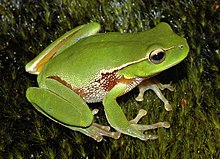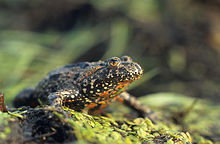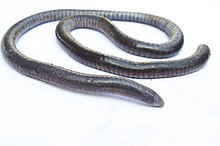The Amphibian Portal
Amphibians are ectothermic, anamniotic, four-limbed vertebrate animals that constitute the class Amphibia. In its broadest sense, it is a paraphyletic group encompassing all tetrapods, excluding the amniotes (tetrapods with an amniotic membrane, such as modern reptiles, birds, and mammals). All extant (living) amphibians belong to the monophyletic subclass Lissamphibia, with three living orders: Anura (frogs), Urodela (salamanders), and Gymnophiona (caecilians). Evolved to be mostly semiaquatic, amphibians have adapted to inhabit a wide variety of habitats, with most species living in freshwater, wetland or terrestrial ecosystems (such as riparian woodland, fossorial and even arboreal habitats). Their life cycle typically starts out as aquatic larvae with gills known as tadpoles, but some species have developed behavioural adaptations to bypass this.
The young generally undergo metamorphosis from larva with gills to an adult air-breathing form with lungs. Amphibians use their skin as a secondary respiratory surface and some small terrestrial salamanders and frogs lack lungs and rely entirely on their skin. They are superficially similar to reptiles like lizards, but unlike reptiles and other amniotes, require water bodies in which to breed. With their complex reproductive needs and permeable skins, amphibians are often ecological indicators; in recent decades there has been a dramatic decline in amphibian populations for many species around the globe.
The earliest amphibians evolved in the Devonian period from sarcopterygian fish with lungs and bony-limbed fins, features that were helpful in adapting to dry land. They diversified and became ecologically dominant during the Carboniferous and Permian periods, but were later displaced in terrestrial environments by early reptiles and basal synapsids (mammal predecessors). The origin of modern amphibians belonging to Lissamphibia, which first appeared during the Early Triassic, around 250 million years ago, has long been contentious. The most popular hypothesis is that they likely originated from temnospondyls, the most diverse group of prehistoric amphibians, during the Permian period. Another hypothesis is that they emerged from lepospondys. (Full article...)
Selected frog article
The Mesobatrachia (Ancient Greek μέσος (mésos, "middle") + batrachia ("frogs")) is a paraphyletic group of relatively primitive frogs. At the end of 2016, it contained 3 superfamilies (Pelobatoidea, Pelodytoidea and Pipoidea), 6 families, 16 genera, and 244 species. Recognized as a group in 1993, the name is contrasted with the primitive Archaeobatrachia and the more diverse and advanced Neobatrachia.
The Mesobatrachia comprise five fossorial families, including the spadefoot toads of Europe, North America, and East Asia, the parsley frogs, and the Mexican burrowing toad, as well as one obligatorily aquatic family, the Pipidae of Africa and South America. Later studies recognised that the group was paraphyletic with respect to Neobatrachia.
The families currently accepted in the Mesobatrachia suborder are: (Full article...)Selected salamander article

List of selected salamander articles
|
|---|
Did you know? –

- ... that the Mexican burrowing caecilian (pictured) is viviparous, with the young feeding on glandular secretions in the oviduct?
- ... that the red-cheeked salamander, which is distasteful to predators, is mimicked by the harmless imitator salamander?
- ... that the Black Salamander may defend itself by biting a western garter snake attacking it?
- ... that the Ouachita Dusky Salamander, the Fourche Mountain Salamander (pictured), and the Rich Mountain Salamander are all endemic to the Ouachita Mountains in Arkansas and Oklahoma?
- ...that the American toad is a common species of toad found throughout the eastern United States and Canada?
Selected amphibian type
Toad is a common name for certain frogs, especially of the family Bufonidae, that are characterized by dry, leathery skin, short legs, and large bumps covering the parotoid glands.
A distinction between frogs and toads is not made in scientific taxonomy, but is common in popular culture (folk taxonomy), in which toads are associated with drier, rougher skin and more terrestrial habitats. (Full article...)List of selected amphibian type articles
|
|---|
Selected images
Selected toad article
Selected caecilian article
Caecilians (/sɪˈsɪliən/; New Latin for 'blind ones') are a group of limbless, vermiform (worm-shaped) or serpentine (snake-shaped) amphibians with small or sometimes nonexistent eyes. They mostly live hidden in soil or in streambeds, and this cryptic lifestyle renders caecilians among the least familiar amphibians. Modern caecilians live in the tropics of South and Central America, Africa, and southern Asia. Caecilians feed on small subterranean creatures such as earthworms. The body is cylindrical and often darkly coloured, and the skull is bullet-shaped and strongly built. Caecilian heads have several unique adaptations, including fused cranial and jaw bones, a two-part system of jaw muscles, and a chemosensory tentacle in front of the eye. The skin is slimy and bears ringlike markings or grooves and may contain scales.
Modern caecilians are a clade, the order Gymnophiona' /ˌdʒɪmnəˈfaɪənə/ (or Apoda /ˈæpədə/), one of the three living amphibian groups alongside Anura (frogs) and Urodela (salamanders). Gymnophiona is a crown group, encompassing all modern caecilians and all descendants of their last common ancestor. There are more than 220 living species of caecilian classified in 10 families. Gymnophionomorpha is a recently coined name for the corresponding total group which includes Gymnophiona as well as a few extinct stem-group caecilians (extinct amphibians whose closest living relatives are caecilians but are not descended from any caecilian). Some palaeontologists have used the name Gymnophiona for the total group and the old name Apoda for the crown group'. However, Apoda has other even older uses, including as the name of a genus of Butterfly making its use potentially confusing and best avoided. 'Gymnophiona' derives from the Greek words γυμνος / gymnos (Ancient Greek for 'naked') and οφις / ophis (Ancient Greek for 'snake'), as the caecilians were originally thought to be related to snakes and to lack scales.
The study of caecilian evolution is complicated by their poor fossil record and specialized anatomy. Genetic evidence and some anatomical details (such as pedicellate teeth) support the idea that frogs, salamanders, and caecilians (collectively known as lissamphibians) are each others' closest relatives. Frogs and salamanders show many similarities to dissorophoids, a group of extinct amphibians in the order Temnospondyli. Caecilians are more controversial; many studies extend dissorophoid ancestry to caecilians. Some studies have instead argued that caecilians descend from extinct lepospondyl or stereospondyl amphibians, contradicting evidence for lissamphibian monophyly (common ancestry). Rare fossils of early gymnophionans such as Eocaecilia and Funcusvermis have helped to test the various conflicting hypotheses for the relationships between caecilians and other living and extinct amphibians. (Full article...)Need help?
Do you have a question about Amphibians that you can't find the answer to?
Consider asking it at the Wikipedia reference desk.
Topics
Subcategories
Related portals
Associated Wikimedia
The following Wikimedia Foundation sister projects provide more on this subject:
-
Commons
Free media repository -
Wikibooks
Free textbooks and manuals -
Wikidata
Free knowledge base -
Wikinews
Free-content news -
Wikiquote
Collection of quotations -
Wikisource
Free-content library -
Wikiversity
Free learning tools -
Wiktionary
Dictionary and thesaurus
© MMXXIII Rich X Search. We shall prevail. All rights reserved. Rich X Search











































